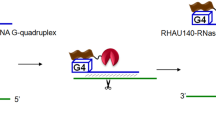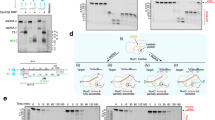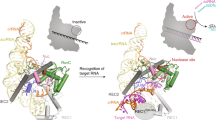Abstract
The siRNA-directed ribonucleoprotein complex, RISC, catalyzes target RNA cleavage in the RNA interference pathway. Here, we show that siRNA-programmed RISC is a classical Michaelis-Menten enzyme in the presence of ATP. In the absence of ATP, the rate of multiple rounds of catalysis is limited by release of the cleaved products from the enzyme. Kinetic analysis suggests that different regions of the siRNA play distinct roles in the cycle of target recognition, cleavage, and product release. Bases near the siRNA 5′ end disproportionately contribute to target RNA-binding energy, whereas base pairs formed by the central and 3′ regions of the siRNA provide a helical geometry required for catalysis. Finally, the position of the scissile phosphate on the target RNA seems to be determined during RISC assembly, before the siRNA encounters its RNA target.
This is a preview of subscription content, access via your institution
Access options
Subscribe to this journal
Receive 12 print issues and online access
$189.00 per year
only $15.75 per issue
Buy this article
- Purchase on Springer Link
- Instant access to full article PDF
Prices may be subject to local taxes which are calculated during checkout






Similar content being viewed by others
References
Fire, A. et al. Potent and specific genetic interference by double-stranded RNA in Caenorhabditis elegans. Nature 391, 806–811 (1998).
Elbashir, S.M., Lendeckel, W. & Tuschl, T. RNA interference is mediated by 21- and 22-nucleotide RNAs. Genes Dev. 15, 188–200 (2001).
Nykänen, A., Haley, B. & Zamore, P.D. ATP requirements and small interfering RNA structure in the RNA interference pathway. Cell 107, 309–321 (2001).
Martinez, J., Patkaniowska, A., Urlaub, H., Lührmann, R. & Tuschl, T. Single-stranded antisense siRNA guide target RNA cleavage in RNAi. Cell 110, 563–574 (2002).
Hammond, S.M., Bernstein, E., Beach, D. & Hannon, G.J. An RNA-directed nuclease mediates post-transcriptional gene silencing in Drosophila cells. Nature 404, 293–296 (2000).
Hannon, G.J. & Zamore, P.D. Small RNAs, big biology and biochemical studies of RNA interference. In RNAi: A Guide To Gene Silencing (ed. Hannon, G.J.) 87–108 (Cold Spring Harbor Laboratory Press, Cold Spring Harbor, NY, 2003).
Elbashir, S.M. et al. Duplexes of 21-nucleotide RNAs mediate RNA interference in cultured mammalian cells. Nature 411, 494–498 (2001).
Amarzguioui, M., Holen, T., Babaie, E. & Prydz, H. Tolerance for mutations and chemical modifications in a siRNA. Nucleic Acids Res. 31, 589–595 (2003).
Elbashir, S.M., Martinez, J., Patkaniowska, A., Lendeckel, W. & Tuschl, T. Functional anatomy of siRNAs for mediating efficient RNAi in Drosophila melanogaster embryo lysate. EMBO J. 20, 6877–6888 (2001).
Holen, T., Amarzguioui, M., Babaie, E. & Prydz, H. Similar behaviour of single-strand and double-strand siRNAs suggests they act through a common RNAi pathway. Nucleic Acids Res. 31, 2401–2407 (2003).
Tang, G., Reinhart, B.J., Bartel, D.P. & Zamore, P.D. A biochemical framework for RNA silencing in plants. Genes Dev. 17, 49–63 (2003).
Phipps, K.M., Martinez, A., Lu, J., Heinz, B.A. & Zhao, G. Small interfering RNA molecules as potential anti-human rhinovirus agents: in vitro potency, specificity, and mechanism. Antiviral Res. 61, 49–55 (2004).
Ding, H. et al. Selective silencing by RNAi of a dominant allele that causes amyotrophic lateral sclerosis. Aging Cell 2, 209–217 (2003).
Jackson, A.L. et al. Expression profiling reveals off-target gene regulation by RNAi. Nat. Biotechnol. 21, 635–637 (2003).
Bartel, D.P. MicroRNAs: genomics, biogenesis, mechanism, and function. Cell 116, 281–297 (2004).
Rajewsky, N. & Socci, N.D. Computational identification of microRNA targets. Dev. Biol. 267, 529–535 (2004).
Lai, E.C. Micro RNAs are complementary to 3′ UTR sequence motifs that mediate negative post-transcriptional regulation. Nat. Genet. 30, 363–364 (2002).
Doench, J.G. & Sharp, P.A. Specificity of microRNA target selection in translational repression. Genes Dev. 18, 504–511 (2004).
Chiu, Y.L. & Rana, T.M. siRNA function in RNAi: a chemical modification analysis. RNA 9, 1034–1048 (2003).
Hutvágner, G. & Zamore, P.D. A microRNA in a multiple-turnover RNAi enzyme complex. Science 297, 2056–2060 (2002).
Hutvágner, G., Simard, M.J., Mello, C.C. & Zamore, P.D. Sequence-specific inhibition of small RNA function. PLoS Biol. 2, 1–11 (2004).
Schwarz, D.S. et al. Asymmetry in the assembly of the RNAi enzyme complex. Cell 115, 199–208 (2003).
Lewis, B., Shih, I., Jones-Rhoades, M., Bartel, D. & Burge, C. Prediction of mammalian microRNA targets. Cell 115, 787–798 (2003).
Rhoades, M.W. et al. Prediction of plant microRNA targets. Cell 110, 513–520 (2002).
Stark, A., Brennecke, J., Russel, R. & Cohen, S. Identification of Drosophila microRNA targets. PLoS Biol. 1, 1–13 (2003).
Chiu, Y.-L. & Rana, T.M. RNAi in human cells: basic structural and functional features of small interfering RNA. Molecular Cell 10, 549–561 (2002).
Lima, W.F. & Crooke, S.T. Binding affinity and specificity of Escherichia coli RNase H1: impact on the kinetics of catalysis of antisense oligonucleotide-RNA hybrids. Biochemistry 36, 390–398 (1997).
Meister, G., Landthaler, M., Dorsett, Y. & Tuschl, T. Sequence-specific inhibition of microRNA- and siRNA-induced RNA silencing. RNA 10, 544–550 (2004).
Tomari, Y. et al. RISC assembly defects in the Drosophila RNAi mutant armitage. Cell 116, 831–841 (2004).
Reynolds, A. et al. Rational siRNA design for RNA interference. Nat. Biotechnol. 22, 326–330 (2004).
Stryer, L. Biochemistry. (W. H. Freeman and Company, San Francisco; 1981).
Martinez, J. & Tuschl, T. RISC is a 5′ phosphomonoester-producing RNA endonuclease. Genes Dev. 18, 975–980 (2004).
Pham, J.W., Pellino, J.L., Lee, Y.S., Carthew, R.W. & Sontheimer, E.J. A Dicer-2-dependent 80S complex cleaves targeted mRNAs during RNAi in Drosophila. Cell 117, 83–94 (2004).
Enright, A. et al. MicroRNA targets in Drosophila. Genome Biol. 5, R1 (2003).
Lee, R.C., Feinbaum, R.L. & Ambros, V. The C. elegans heterochronic gene lin-4 encodes small RNAs with antisense complementarity to lin-14. Cell 75, 843–854. (1993).
Reinhart, B.J. et al. The 21-nucleotide let-7 RNA regulates developmental timing in Caenorhabditis elegans. Nature 403, 901–906. (2000).
Brennecke, J., Hipfner, D.R., Stark, A., Russell, R.B. & Cohen, S.M. bantam encodes a developmentally regulated microRNA that controls cell proliferation and regulates the proapoptotic gene hid in Drosophila. Cell 113, 25–36 (2003).
Abrahante, J.E. et al. The Caenorhabditis elegans hunchback-like gene lin-57/hbl-1 controls developmental timing and is regulated by microRNAs. Dev. Cell 4, 625–637 (2003).
Vella, M., Choi, E., Lin, S., Reinert, K. & Slack, F. The C. elegans microRNA let-7 binds to imperfect let-7 complementary sites from the lin-41 3′UTR. Genes Dev. 18, 132–137 (2004).
Xu, P., Vernooy, S.Y., Guo, M. & Hay, B.A. The Drosophila microRNA miR-14 suppresses cell death and is required for normal fat metabolism. Curr. Biol. 13, 790–795 (2003).
Johnston, R.J. & Hobert, O. A microRNA controlling left/right neuronal asymmetry in Caenorhabditis elegans. Nature 426, 845–849 (2003).
Haley, B., Tang, G. & Zamore, P.D. In vitro analysis of RNA interference in Drosophila melanogaster. Methods 30, 330–336 (2003).
Schwarz, D.S., Tomari, Y. & Zamore, P.D. The RNA-induced silencing complex is a Mg2+-dependent endonuclease. Curr. Biol. 14, 787–791 (2004).
Voet, D. & Voet, J.G. Biochemistry. (John Wiley & Sons, Hoboken, NJ; 2004).
Wu, H., Lima, W.F. & Crooke, S.T. Investigating the structure of human RNase H1 by site-directed mutagenesis. J. Biol. Chem. 276, 23547–23553. (2001).
Acknowledgements
We thank J. McLachlan for maintaining our fly colony, and members of the Zamore lab, S. Blacklow, T. Carruthers and D. Turner for encouragement, helpful discussions and comments on the manuscript. P.D.Z. is a Pew scholar in the biomedical sciences and a W.M. Keck Foundation young scholar in medical research. This work was supported in part by grants from the US National Institutes of Health to P.D.Z. (GM62862-01 and GM65236-01).
Author information
Authors and Affiliations
Corresponding author
Ethics declarations
Competing interests
P.D.Z. is a cofounder of Alnylam Pharmaceuticals, a biotechnology company devoted to the development of RNAi-based therapeutics.
Supplementary information
Supplementary Figure 1
Exogenously programmed RISC is an enzyme. (PDF 46 kb)
Supplementary Figure 2
Michaelis-Menten and competitor analysis of RISC. (PDF 29 kb)
Supplementary Figure 3
RNAs used in this study. (PDF 424 kb)
Rights and permissions
About this article
Cite this article
Haley, B., Zamore, P. Kinetic analysis of the RNAi enzyme complex. Nat Struct Mol Biol 11, 599–606 (2004). https://doi.org/10.1038/nsmb780
Received:
Accepted:
Published:
Issue Date:
DOI: https://doi.org/10.1038/nsmb780
This article is cited by
-
RNA interference in the era of nucleic acid therapeutics
Nature Biotechnology (2024)
-
Single-molecule FRET uncovers hidden conformations and dynamics of human Argonaute 2
Nature Communications (2022)
-
Chemical engineering of therapeutic siRNAs for allele-specific gene silencing in Huntington’s disease models
Nature Communications (2022)
-
GTSF1 accelerates target RNA cleavage by PIWI-clade Argonaute proteins
Nature (2022)
-
PIWI-interacting RNAs: small RNAs with big functions
Nature Reviews Genetics (2019)



